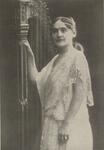
Henriette RENIÉ
1875 - 1956
Composer, Harpist
Henriette Renié, the daughter of a singer who studied with Rossini, discovered the instrument which was to make her famous at a concert given by Alphonse Hasselmans in Nice. She was only five at the time, so while waiting to take up the harp, she learnt the piano instead. When she was eight, her father invented extensions to help her reach the pedals of her harp. The rapid progress she made earned her a place in the class of Hasselmans at the Paris Conservatoire: there she was unanimously awarded the Premier Prix for harp at the age of eleven. She continued her training by attending theory classes: at the age of thirteen, an exception was made for her to attend the classes taught by Théodore Dubois (harmony), then by Charles Lenepveu (counterpoint and fugue). She made her debut as a concert harpist and composer under the baton of Camille Chevillard (Concerts Lamoureux) on 24 March 1901 with her Concerto pour harpe. From then on, the young virtuoso established the harp as a major solo instrument in the leading French orchestral concert series. At the same time, she pursued her teaching career outside the Paris Conservatoire, a Republican institution that was reluctant to open its doors to an overtly Catholic and conservative teacher. Nevertheless, she taught some renowned harpists (among others, Marcel Grandjany and Louise Charpentier), founded an international harp competition (1914) and left a Méthode de harpe (1946) to posterity. The works she composed were written almost exclusively for her instrument, with the notable exception of a superb Sonata for cello and piano.
Focus
Focus
Romantic Harp
Focus
Compositrices
Documents and archives

Testimonial, Biographical material, Manuscript document






